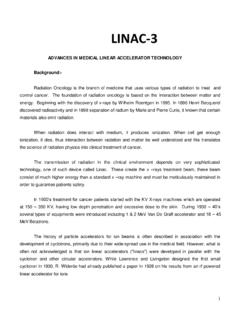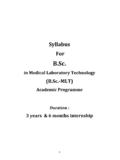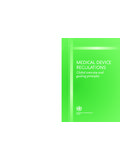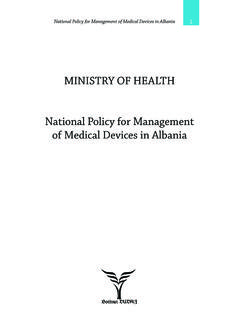Transcription of California Association for Medical Laboratory Technology
1 California Association for Medical Laboratory Technology Distance Learning Program PATIENT IDENTIFICATION Course # DL-9 63 by Patricia L. Fawkes, CLS Kaweah Delta Healthcare District Transfusion Service Visalia, CA Approved for CE CAMLT is approved by the California Department of Public Health as a CA CLS Accrediting Agency (#0021) Level of Difficulty: Basic 1895 Mowry Ave., Ste. 112 Phone: 510-792-4441 Fremont, CA 94538-1766 FAX: 510-792-3045 Notification of Distance Learning Deadline DON T PUT YOUR LICENSE IN JEOPARDY! This is a reminder that all the continuing education units required to renew your license/certificate must be earned no later than the expiration date printed on your license/certificate. If some of your units are made up of Distance Learning courses, please allow yourself enough time to retake the test in the event you do not pass on the first attempt.
2 CAMLT urges you to earn your CE units early! DISTANCE LEARNING ANSWER SHEET Please circle the one best answer for each question. COURSE NAME: PATIENT IDENTIFICATION COURSE # DL-963 NAME _____ CLS LIC. # _____ DATE _____ SIGNATURE (REQUIRED) _____ ADDRESS _____ STREET CITY STATE/ZIP 1. a b c d 2. a b c d 3. a b c d 4. a b c d 5. a b c d 6. a b c d 7. a b c d 8. a b c d 9. a b c d 10. a b c d DISTANCE LEARNING EVALUATION FORM According to state regulations, this form must be completed and returned in order to receive CE hours. Your comments help us to provide you with better continuing education materials in the distance learning format. Please circle the number that agrees with your assessment with, with 5 meaning you strongly agree and 1 meaning you strongly disagree.
3 1. Overall, I was satisfied with the quality of this Distance Learning course. 5 4 3 2 1 2. The objectives of this Distance Learning course were met. 5 4 3 2 1 3. The difficulty of this Distance Learning course was consistent with the number of CE hours. 5 4 3 2 1 4. I will use what I learned from this Distance Learning course. 5 4 3 2 1 5. The time to complete this Distance Learning course was: _____ hours 6. Please comment on this Distance Learning course on the back of this sheet. What did you like or dislike? CAMLT Distance Learning Course DL-963 CAMLT 2014 Page 1 PATIENT IDENTIFICATION Course Number: DL-963 CE Level of Difficulty: Basic Patricia L. Fawkes, CLS Kaweah Delta Healthcare District Transfusion Service Visalia, CA INTRODUCTION: In preparing for blood collection, each phlebotomist or other healthcare worker generally establishes a routine that is comfortable for him or her.
4 Several essential steps are part of every successful collection procedure, but the most important task a phlebotomist has to do is properly identify the patient. Patient Identification is the process by which a worker verifies the fact that a patient is the same as the one described on the requisition or physician order. This continuing education unit will be emphasizing this important aspect of sample collection. OBJECTIVES: At the end of this course, the participant will be able to: 1. Discuss the importance of correct patient identification 2. Define proper patient identification for both inpatients and outpatients 3. Explain the two-step process of the specimen collection procedure 4. Identify the difference between general labeling of a Laboratory sample with the identification of a blood bank sample DISCUSSION: If the incorrect name is placed on a blood specimen, the consequences to the patient may be catastrophic.
5 A mislabeled specimen could result in the patient s receiving a transfusion of the wrong blood type or could change the course of diagnosis, treatment or medication. All the effort the phlebotomist has expended in obtaining the proper specimen and all the time and expense the Laboratory personnel have spent in analyzing the specimen will be wasted if the specimen is identified with the incorrect name. If the identification of the specimen is in doubt at any time during the specimen collection, specimen transportation, specimen processing or testing phase, the specimen should be discarded and another blood sample should be drawn. Most experts recommend a two-step process to the specimen collection procedure. As the first step, the patient should be asked to state his or her first and last names. It is not recommended to say something such as, Are you Mrs.
6 Smith? A person who is very ill, hard of hearing or sedated may say yes to anything asked. It is helpful to use a memory jogger such as having the patient spell his/her name or perhaps the phlebotomist could comment on the patient s name in order to spark a conversation. The second step is to make a confirmatory match using the patient s response with the test requisition and some type of identification such as a hospital identification armband. CAMLT Distance Learning Course DL-963 CAMLT 2014 Page 2 Whether the phlebotomist is drawing an inpatient, outpatient, adult or pediatric patient, proper identification should be the very first procedure. As Technology has advanced, so have identification methods. The use of bar coded labels for the patient s samples can be used to reduce transcription errors and speed up sample processing.
7 Bar codes represent a series of light and dark bands of varying widths. The configuration of these bands relates to a specific alpha numeric symbol (numbers and letters). 1 When these bands are placed together in a series, they correspond to a patient s name or an identification number. When the bar is scanned with a sensitive light or laser scanner, the series of numbers and letters is read into a computer in a precise manner. This Technology is very fast and accurate. It saves time, substantially reduces clerical errors and is used most often in larger organizations. An example of the use of this Technology is being used in hospitals. Handheld bar code readers can relay information from the patient s ID band to a handheld printer to yield patient labels for specimen labeling at the bedside. The labels contain the patient s name, Medical record number, date of birth, tests requested, and type of specimen tube to be drawn.
8 There is also a two-dimensional bar code Technology . This Technology has the capability of holding entire databases in the code, thus enabling more information to be encoded on the patient from collection to testing. Still another Technology available is wireless Technology , such as radio frequency identification (RFID) which uses radio waves to transmit data. The Technology has the potential of holding more information than a single linear bar code. In fact, it holds more in a way of a tag . Essentially, a "tag" about the size of a penny is created for the patient that will accompany the specimen throughout the Laboratory and instantly uploads information as the tag is scanned at various points in the testing process. There is also a wristband available that contains a microchip which stores up to 80 pages of information about a Each new identification system must be evaluated for accuracy, cost-effectiveness, compatibility with existing computer system and training involved.
9 INPATIENT IDENTIFICATION: In-patients are normally required to wear an identification bracelet, usually on the wrist. Although identification protocol may vary slightly from one healthcare institution to another, the typical ID band lists the patient s name (first and last) and a unique hospital identification number such as a Medical record number. Additional information includes the patient s visit number, date of birth, room number and bed designation, and physician s name. The patient s name, Medical record number and date of birth information on the ID armband must exactly match the information on the Laboratory requisition or label. Generally, ID information such as room number, bed number and physician s name are allowed to differ since the patient may be moved around and may be seen by multiple physicians during the hospital stay.
10 The name card on the bed or door should never be used for confirming identity because it is often the last thing to be changed when patients are discharged and new patients admitted. What if the patient does not have an identification armband? If there is no ID band on either of the patient s wrists, check to see if one is on the ankle. Intravenous lines in patient s arms often infiltrate the surrounding tissues and cause swelling that necessitates the removal of the ID band. An ID band on an intravenous (IV) pole or night table could belong to a patient who previously occupied that bed and should not be used. Remember; never verify information from an ID band that is not attached to the patient. The best identification in the case of a missing ID CAMLT Distance Learning Course DL-963 CAMLT 2014 Page 3 band is to find the nurse responsible for the patient and ask him or her to make the patient identification and then to attach an identification armband before collecting the specimen.









